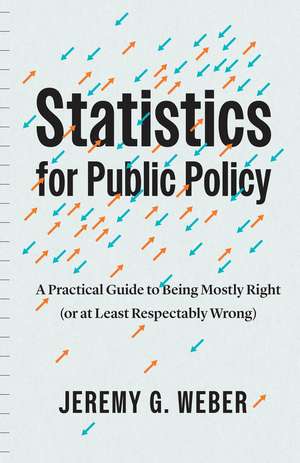Statistics for Public Policy: A Practical Guide to Being Mostly Right (or at Least Respectably Wrong)
Autor Jeremy G. Weberen Limba Engleză Paperback – 16 ian 2024
Statistics are an essential tool for making, evaluating, and improving public policy. Statistics for Public Policy is a crash course in wielding these unruly tools to bring maximum clarity to policy work. Former White House economist Jeremy G. Weber offers an accessible voice of experience for the challenges of this work, focusing on seven core practices:
- Thinking big-picture about the role of data in decisions
- Critically engaging with data by focusing on its origins, purpose, and generalizability
- Understanding the strengths and limits of the simple statistics that dominate most policy discussions
- Developing reasons for considering a number to be practically small or large
- Distinguishing correlation from causation and minor causes from major causes
- Communicating statistics so that they are seen, understood, and believed
- Maintaining credibility by being right (or at least respectably wrong) in every setting
| Toate formatele și edițiile | Preț | Express |
|---|---|---|
| Paperback (1) | 153.41 lei 3-5 săpt. | +9.75 lei 6-12 zile |
| University of Chicago Press – 16 ian 2024 | 153.41 lei 3-5 săpt. | +9.75 lei 6-12 zile |
| Hardback (1) | 591.22 lei 3-5 săpt. | +17.62 lei 6-12 zile |
| University of Chicago Press – 13 feb 2024 | 591.22 lei 3-5 săpt. | +17.62 lei 6-12 zile |
Preț: 153.41 lei
Nou
Puncte Express: 230
Preț estimativ în valută:
29.36€ • 31.39$ • 24.48£
29.36€ • 31.39$ • 24.48£
Carte disponibilă
Livrare economică 28 martie-11 aprilie
Livrare express 13-19 martie pentru 19.74 lei
Preluare comenzi: 021 569.72.76
Specificații
ISBN-13: 9780226830759
ISBN-10: 0226830756
Pagini: 192
Ilustrații: 17 line drawings, 2 tables
Dimensiuni: 140 x 216 x 18 mm
Greutate: 0.25 kg
Ediția:First Edition
Editura: University of Chicago Press
Colecția University of Chicago Press
ISBN-10: 0226830756
Pagini: 192
Ilustrații: 17 line drawings, 2 tables
Dimensiuni: 140 x 216 x 18 mm
Greutate: 0.25 kg
Ediția:First Edition
Editura: University of Chicago Press
Colecția University of Chicago Press
Notă biografică
Jeremy G. Weber is professor in the University of Pittsburgh Graduate School of Public and International Affairs. He previously served as a chief economist for the White House Council of Economic Advisers.
Cuprins
Preface
1. The Big Picture
2. Know Your Sample and Data
3. Know Simple Statistics and Their Power
4. Know What It Means to Account for Potholes
5. Know Large from Small and Explain the Difference
6. Think Hard about Causality
7. Show That You’ve Been to Table School
8. Know How to Be Mostly Right (or at Least Respectfully Wrong)
9. Fail the Test? A Case Study in Using Statistics for Policy
Acknowledgments
Notes
Bibliography
Index
1. The Big Picture
2. Know Your Sample and Data
3. Know Simple Statistics and Their Power
4. Know What It Means to Account for Potholes
5. Know Large from Small and Explain the Difference
6. Think Hard about Causality
7. Show That You’ve Been to Table School
8. Know How to Be Mostly Right (or at Least Respectfully Wrong)
9. Fail the Test? A Case Study in Using Statistics for Policy
Acknowledgments
Notes
Bibliography
Index
Recenzii
"[Statistics for Public Policy] discusses principles for using statistics to further the understanding of people making decisions, highlighting the importance of integrating statistical knowledge with knowledge of the particulars of a context and issue and of recognizing that statistical standards taught and used in academic settings may not apply in policy settings."
"Weber has written a book that many policy analysts should read. Certainly it will help those with little statistics (and less mathematics), but it should also provoke those already confident in their data skills to think a bit harder about what they are doing."
“Our statistical texts—and often our teaching—ignore the craft that makes quantitative evidence useful for policy makers. In Statistics for Public Policy, Weber draws on his own experience to address the nitty-gritty issues that advisors confront in honestly and effectively interpreting and presenting evidence.”
“The best public policy advisers know how to blend statistical knowledge with an understanding of the context of issues. Weber uses his experience as a White House economist to explain how analysts can make sense of messy real-world data and maintain their credibility even if their numbers turn out to be wrong. Accessible and engaging, Statistics for Public Policy presents practical tips to improve the use of statistics and data in the policy world.”
“An easily digestible and humorous must-read, Statistics for Public Policy takes a fairly dry subject—but one of utmost importance—and infuses it with real world examples that bring statistics alive for the reader. As someone on the receiving end of many a policy memo, I can say with certainty that every would-be wonk could benefit from this book."
